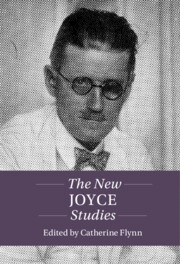Book contents
- The New Joyce Studies
- Twenty-First-Century Critical Revisions
- The New Joyce Studies
- Copyright page
- Contents
- Figures
- Notes on Contributors
- Acknowledgments
- Abbreviations
- Introduction
- Part I Scope
- Part II Fragment and Frame
- Chapter 8 The Intertextual Condition
- Chapter 9 The Macrogenesis of Ulysses and Finnegans Wake
- Chapter 10 After The Little Review
- Chapter 11 Popular Joyce, for Better or Worse
- Part III Perspective
- Bibliography
- Index
Chapter 11 - Popular Joyce, for Better or Worse
from Part II - Fragment and Frame
Published online by Cambridge University Press: 01 September 2022
- The New Joyce Studies
- Twenty-First-Century Critical Revisions
- The New Joyce Studies
- Copyright page
- Contents
- Figures
- Notes on Contributors
- Acknowledgments
- Abbreviations
- Introduction
- Part I Scope
- Part II Fragment and Frame
- Chapter 8 The Intertextual Condition
- Chapter 9 The Macrogenesis of Ulysses and Finnegans Wake
- Chapter 10 After The Little Review
- Chapter 11 Popular Joyce, for Better or Worse
- Part III Perspective
- Bibliography
- Index
Summary
Earle’s chapter considers the implications of the early appearance of Joyce’s writings in pulp fiction outlets. Building on his previous work, Recovering Modernism: Pulps, Paperbacks, and the Prejudice of Form (2009), the chapter considers the significance of the after-life of Joycean texts, circulating as pulp fiction in the popular sphere, reflecting on the broader stakes of modernism as an organizational or conceptual category. The dispute over the “high” or “low” nature of Joyce’s oeuvre allows us to examine not just the vexed relationship between modernism and mass culture but also the nature of popular outlets. What does their publication of Joyce tell us about the values underpinning pulp magazines? The chapter considers how criticism tends to “cherry pick” Joyce, and how his work lends itself to this type of piecemeal exploration (for better or worse). In other words, the manifestations of popular Joyce consisted of very specific pieces of writing, and the dynamics that made them available for such remediation were definitely not true of other pieces. This observation points to the importance of celebrating the fragmentary nature of modernism, illustrating a new modernist studies that resists cohesive understandings of modernism.
- Type
- Chapter
- Information
- The New Joyce Studies , pp. 173 - 190Publisher: Cambridge University PressPrint publication year: 2022

